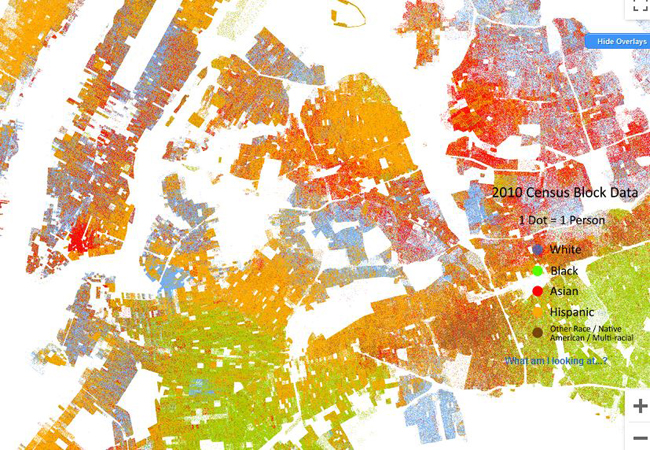
A Census Block mapping resource that shows population by ethnicity (different colors by group) is one of the many resources highlighted in the new Environmental Justice Mapping Tools Guide published by NYSG in 2020.
Contact:
Jessica A. Kuonen, Hudson Estuary Resilience Specialist, NYSG E: jak546@cornell.edu, P: (845) 340-3990 x323
New York Sea Grant has developed an online mapping tools guide that will serve as a data-driven support for community interest in environmental justice
Kingston, NY, March 8, 2021 - Online mapping tools are a powerful way to visualize various disparities in a community. In 2020, COVID-19 provided another example of how long-standing systemic health and social inequities negatively impact people from low income and racial and ethnic minority groups at higher rates. Environmental justice (EJ) recognizes the relationship between race, class, and environmental health, and how some communities are associated with higher exposure to environmental risks and have less capacity to adapt to climate risks.
In 2020, New York Sea Grant (NYSG) created an Environmental Justice Mapping Tools Guide that highlights more than 22 free, publicly-accessible, and easy-to-use online mapping tools to help users access a variety of data through the lens of EJ. These tools cover a range of data that communities, educators, students, and environmental practitioners can use to define and plan EJ-focused projects.
This new guide creates a useful, data-driven framework that acknowledges long-standing systemic inequities and the complex ways that human health is impacted by the environment. It helps to make EJ-focused data and information more accessible to the public and is being used by groups ranging from teachers to community-based organizations to include EJ in interdisciplinary ways.
An “Introduction to Environmental Justice Mapping Tools” webinar (52 minutes) with EJ background information and demonstrations of several of the mapping tools (Neighborhoods at Risk, How’s My Waterway...) featured in the guide is posted on the NYSG Diversity, Equity, and Inclusion webpage at www.nyseagrant.org/deiresources.
Two hundred forty-nine (249) participants from across the state representing 81 organizations participated in the live webinar. Organizations included local, state, and federal government, community-based organizations, consulting firms, educators, and representatives from the health and transportation sectors. Of 105 completed evaluations, 97% of participants found the webinar content helpful, and 93% of those participants indicated they were interested in future webinars to explore the tools in more depth.
This NYSG-developed resource will serve as a data-driven tool to facilitate community knowledge or interest in environmental justice, helping communities to access information to become more resilient and adaptable to climate change.
More Info: New York Sea Grant
New York Sea Grant (NYSG), a cooperative program of Cornell University
and the State University of New York (SUNY), is one of 34 university-based
programs under the National Oceanic and Atmospheric Administration’s
National Sea Grant College Program.
Since 1971, NYSG has represented a statewide network of integrated
research, education and extension services promoting coastal community
economic vitality, environmental sustainability and citizen awareness
and understanding about the State’s marine and Great Lakes resources.
Through NYSG’s efforts, the combined talents of university scientists
and extension specialists help develop and transfer science-based
information to many coastal user groups—businesses and industries,
federal, state and local government decision-makers and agency managers,
educators, the media and the interested public.
The program maintains Great Lakes offices at Cornell University, SUNY
Buffalo, SUNY Oswego and the Wayne County Cooperative Extension office
in Newark. In the State's marine waters, NYSG has offices at Stony Brook
University in Long Island, Brooklyn College and Cornell Cooperative
Extension in NYC and Elmsford and Kingston in the Hudson Valley.
For updates on Sea Grant activities: www.nyseagrant.org has RSS, Facebook, Twitter, Instagram, and YouTube links. NYSG offers a free e-list sign up via www.nyseagrant.org/nycoastlines for its flagship publication, NY Coastlines/Currents, which is published quarterly.